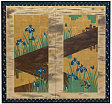
Zoom image
Email to a friend
Print this page
Sakai Hoitsu
Japanese, 1761-1828
Irises and Eight-Fold Bridge, c. 1820
Two-panel screen; ink, color, and gold on silk
132.8 x 117.0 cm
Saint Louis Art Museum,The Langenberg Endowment Fund and funds given by Mary and Oliver Langenberg (20.2007), Obj: 192018
これは、最近セントルイス美術館に収蔵された酒井抱一の円熟した作品で、彼が私淑した尾形光琳(1658–1716)を想起させるものである。板橋が、写実的に描写された燕子花(かきつばた)の間に、配されている。これは、有名な王朝文学作品「伊勢物語」(9世紀末から10世紀初頭成立)に出てくる八橋の場面を表わした作品である。 京を遠くはなれ旅する廷臣が友たちと、燕子花池の八橋の傍らに立ちどまった場面である。廷臣はそれぞれの句の先頭に、「かきつばた」の五文字を読み込んで、最愛の妻の歌を詠んだ。
「唐衣 きつつなれにし つましあれば はるばるきぬる 旅をしぞ思ふ」
友たちは、皆その情の深さに、とめどもなく涙した。
抱一は、尾形光琳の作品にならって燕子花図を数多く描いた。それらは武家と商人の社会のいずれからも、求められた。抱一は、100年前にかつての王朝の都・京都で作られた光琳の作品を復活させ、自分の住む、江戸の教養人たちに受け入れられたのである。
This recent acquisition by the Saint Louis Art Museum, a mature work by the artist Sakai Hoitsu, harks back to his personally chosen master, Ogata Korin (1658–1716). A wooden bridge zigzags through the composition with irises positioned realistically in front and behind, a classical representation of the Eight-fold Bridge scene from the courtly literary masterpiece The Tales of Ise (c. 9th to 10th centuries). In that scene, a courtier far from home stops with his party by a bridge with eight planks amid a marsh of irises. The poem he composes about his beloved wife using each of the syllables of the Japanese word for iris, kakitsubata, as the beginning of each line is so emotional that his companions begin to cry uncontrollably.
Hoitsu did a number of paintings of irises fashioned on those by Ogata Korin, works that were sought after in warrior and merchant circles alike. Hoitsu’s revival of works done in the former imperial capital of Kyoto a hundred years in the past would have appealed to many levels of educated society in his home of Edo (now Tokyo).
Rotation 1: June 26-August 9, 2009
